Abstract
Heavy and light chain variable regions from eight monoclonal Ab2 (anti-idiotypic) antibodies of the GAT antigen, a (Glu60 Ala30 Tyr10)n co-polymer, have been analyzed by direct mRNA sequencing. Three mAb2s were directed against private idiotopes and used various VH-D-JH and Vk-Jk combinations. By contrast, the five 'anti-public' mAb2 antibodies used a very restricted repertoire, including all gene segments. Interestingly, within their D regions, Glu-Glu-Tyr or Tyr-Tyr-Glu sequences were reminiscent of the original (GAT) antigen and may act as possible internal images. A striking observation was that two mAb2 antibodies shared the same V-D-J sequence although derived from separate fusions. As this D sequence, 33 nucleotides long, has not been described so far, it is suggested that it may be encoded by a new germ-line D gene, acting as a crucial regulatory element in a GAT germ-line idiotypic network. An alternative model that may lead to the construction of this D segment by 'odd' rearrangements from pre-existing already reported sequences is also presented.
Full text
PDF

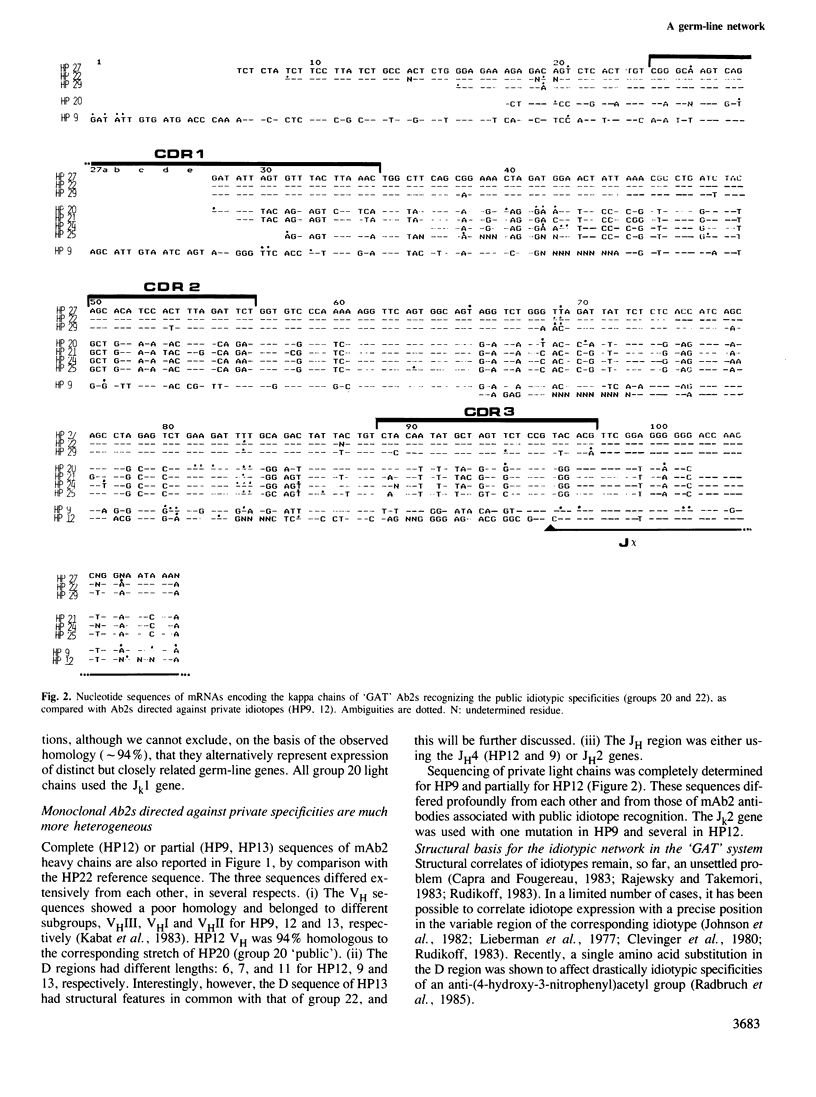
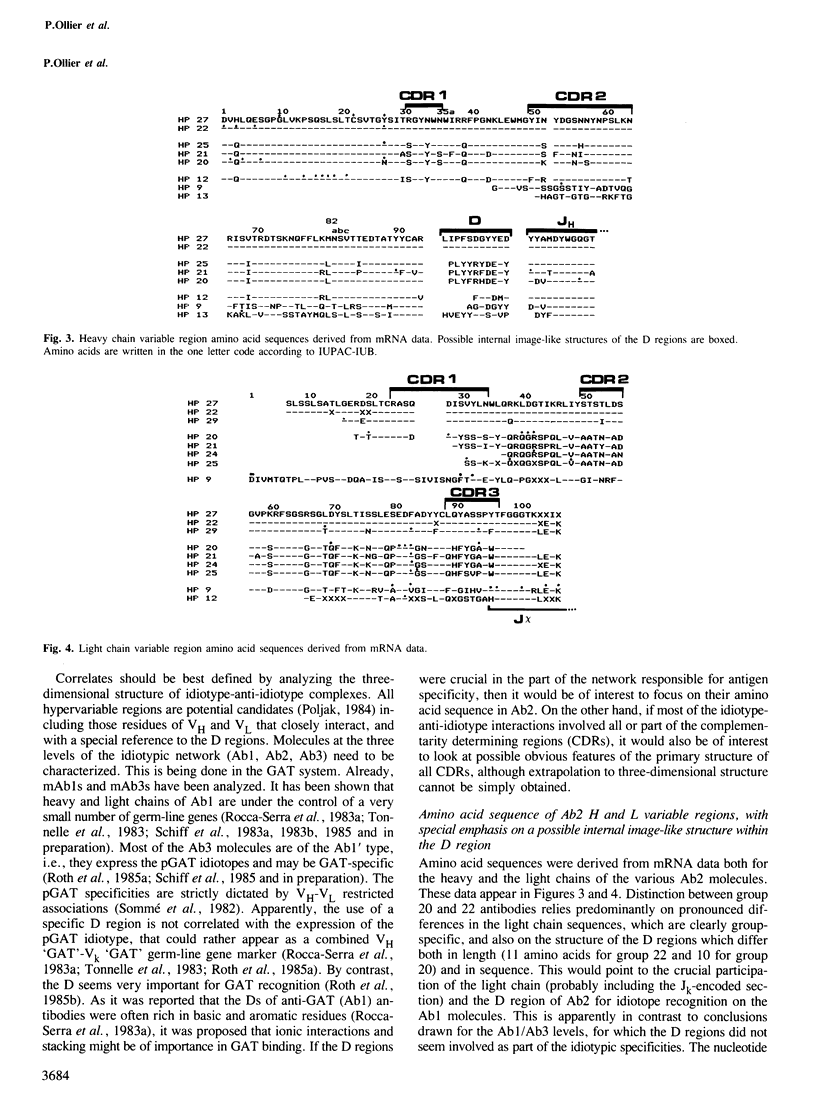
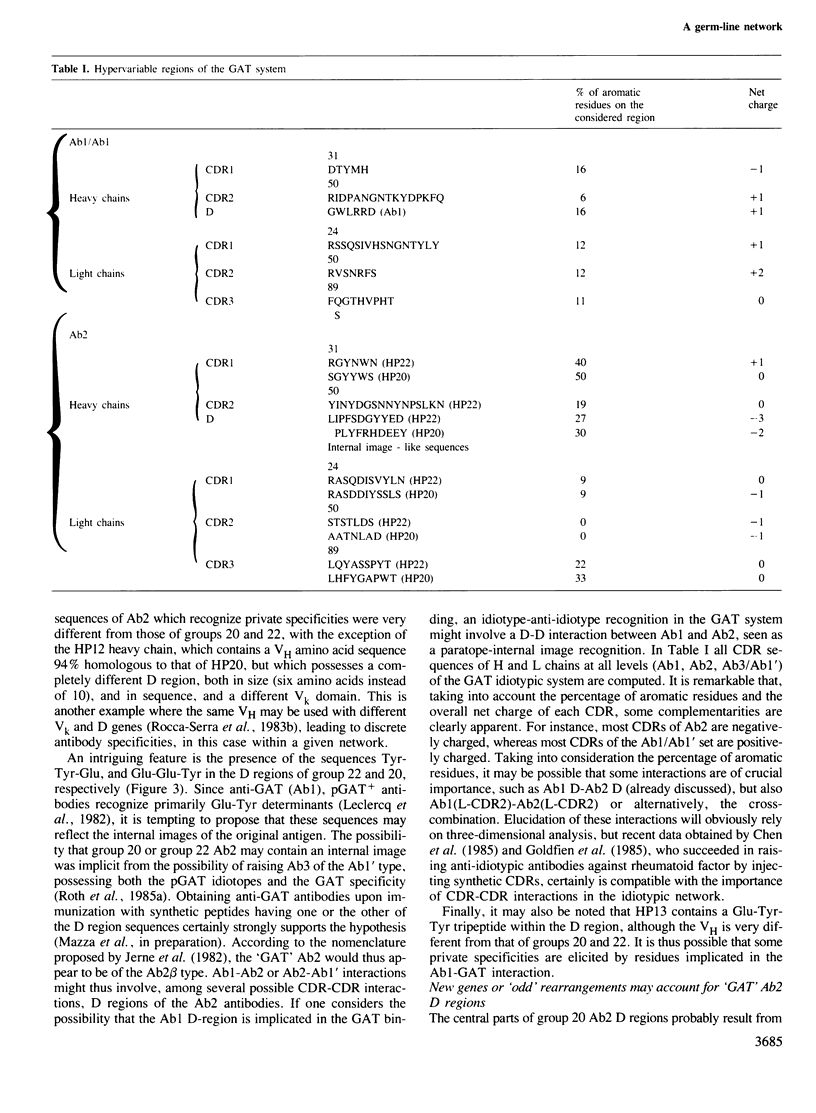
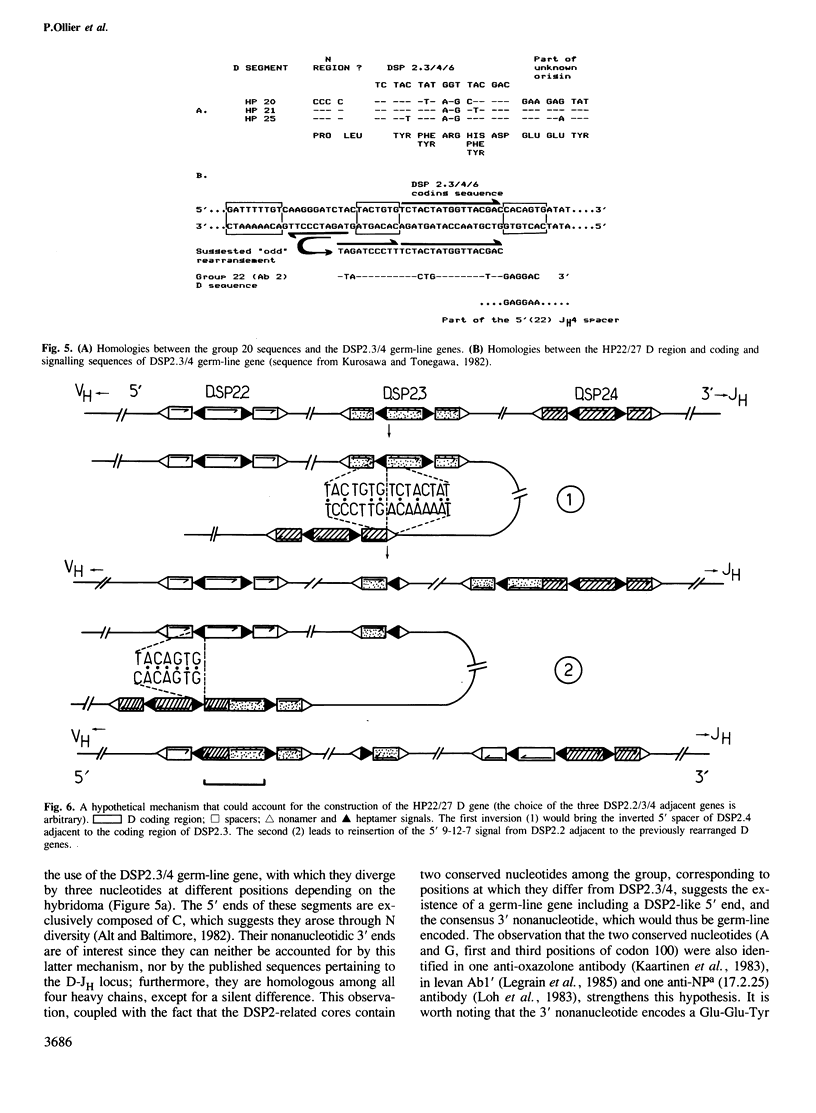
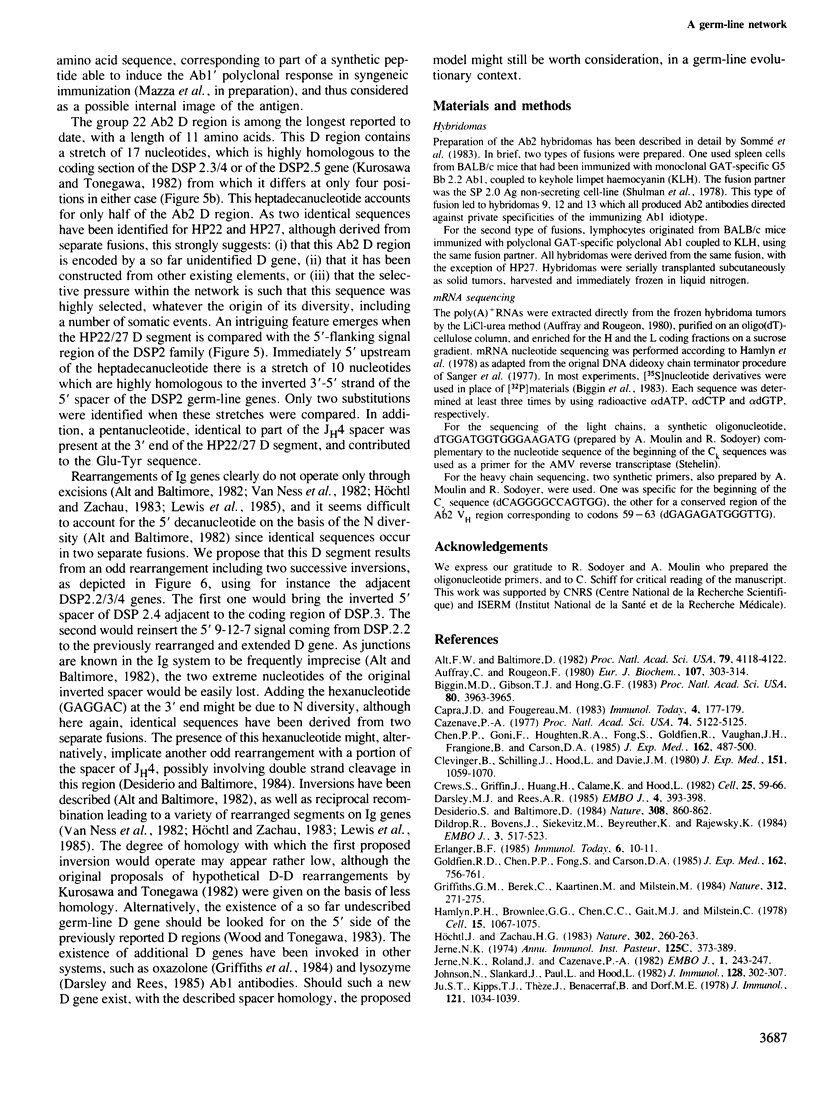

Selected References
These references are in PubMed. This may not be the complete list of references from this article.
- Alt F. W., Baltimore D. Joining of immunoglobulin heavy chain gene segments: implications from a chromosome with evidence of three D-JH fusions. Proc Natl Acad Sci U S A. 1982 Jul;79(13):4118–4122. doi: 10.1073/pnas.79.13.4118. [DOI] [PMC free article] [PubMed] [Google Scholar]
- Auffray C., Rougeon F. Purification of mouse immunoglobulin heavy-chain messenger RNAs from total myeloma tumor RNA. Eur J Biochem. 1980 Jun;107(2):303–314. doi: 10.1111/j.1432-1033.1980.tb06030.x. [DOI] [PubMed] [Google Scholar]
- Biggin M. D., Gibson T. J., Hong G. F. Buffer gradient gels and 35S label as an aid to rapid DNA sequence determination. Proc Natl Acad Sci U S A. 1983 Jul;80(13):3963–3965. doi: 10.1073/pnas.80.13.3963. [DOI] [PMC free article] [PubMed] [Google Scholar]
- Cazenave P. A. Idiotypic-anti-idiotypic regulation of antibody synthesis in rabbits. Proc Natl Acad Sci U S A. 1977 Nov;74(11):5122–5125. doi: 10.1073/pnas.74.11.5122. [DOI] [PMC free article] [PubMed] [Google Scholar]
- Chen P. P., Gõni F., Houghten R. A., Fong S., Goldfien R., Vaughan J. H., Frangione B., Carson D. A. Characterization of human rheumatoid factors with seven antiidiotypes induced by synthetic hypervariable region peptides. J Exp Med. 1985 Aug 1;162(2):487–500. doi: 10.1084/jem.162.2.487. [DOI] [PMC free article] [PubMed] [Google Scholar]
- Clevinger B., Schilling J., Hood L., Davie J. M. Structural correlates of cross-reactive and individual idiotypic determinants on murine antibodies to alpha-(1 leads to 3) dextran. J Exp Med. 1980 May 1;151(5):1059–1070. doi: 10.1084/jem.151.5.1059. [DOI] [PMC free article] [PubMed] [Google Scholar]
- Crews S., Griffin J., Huang H., Calame K., Hood L. A single VH gene segment encodes the immune response to phosphorylcholine: somatic mutation is correlated with the class of the antibody. Cell. 1981 Jul;25(1):59–66. doi: 10.1016/0092-8674(81)90231-2. [DOI] [PubMed] [Google Scholar]
- Darsley M. J., Rees A. R. Nucleotide sequences of five anti-lysozyme monoclonal antibodies. EMBO J. 1985 Feb;4(2):393–398. doi: 10.1002/j.1460-2075.1985.tb03641.x. [DOI] [PMC free article] [PubMed] [Google Scholar]
- Desiderio S., Baltimore D. Double-stranded cleavage by cell extracts near recombinational signal sequences of immunoglobulin genes. 1984 Apr 26-May 2Nature. 308(5962):860–862. doi: 10.1038/308860a0. [DOI] [PubMed] [Google Scholar]
- Dildrop R., Bovens J., Siekevitz M., Beyreuther K., Rajewsky K. A V region determinant (idiotope) expressed at high frequency in B lymphocytes is encoded by a large set of antibody structural genes. EMBO J. 1984 Mar;3(3):517–523. doi: 10.1002/j.1460-2075.1984.tb01840.x. [DOI] [PMC free article] [PubMed] [Google Scholar]
- Goldfien R. D., Chen P. P., Fong S., Carson D. A. Synthetic peptides corresponding to third hypervariable region of human monoclonal IgM rheumatoid factor heavy chains define an immunodominant idiotype. J Exp Med. 1985 Aug 1;162(2):756–761. doi: 10.1084/jem.162.2.756. [DOI] [PMC free article] [PubMed] [Google Scholar]
- Griffiths G. M., Berek C., Kaartinen M., Milstein C. Somatic mutation and the maturation of immune response to 2-phenyl oxazolone. Nature. 1984 Nov 15;312(5991):271–275. doi: 10.1038/312271a0. [DOI] [PubMed] [Google Scholar]
- Hamlyn P. H., Browniee G. G., Cheng C. C., Gait M. J., Milstein C. Complete sequence of constant and 3' noncoding regions of an immunoglobulin mRNA using the dideoxynucleotide method of RNA sequencing. Cell. 1978 Nov;15(3):1067–1075. doi: 10.1016/0092-8674(78)90290-8. [DOI] [PubMed] [Google Scholar]
- Höchtl J., Zachau H. G. A novel type of aberrant recombination in immunoglobulin genes and its implications for V-J joining mechanism. Nature. 1983 Mar 17;302(5905):260–263. doi: 10.1038/302260a0. [DOI] [PubMed] [Google Scholar]
- Jerne N. K., Roland J., Cazenave P. A. Recurrent idiotopes and internal images. EMBO J. 1982;1(2):243–247. doi: 10.1002/j.1460-2075.1982.tb01154.x. [DOI] [PMC free article] [PubMed] [Google Scholar]
- Jerne N. K. Towards a network theory of the immune system. Ann Immunol (Paris) 1974 Jan;125C(1-2):373–389. [PubMed] [Google Scholar]
- Johnson N., Slankard J., Paul L., Hood L. The complete V domain amino acid sequences of two myeloma inulin-binding proteins. J Immunol. 1982 Jan;128(1):302–307. [PubMed] [Google Scholar]
- Ju S. T., Kipps T. J., Theze J., Benacerraf B., Dorf M. E. Idiotypic analysis of anti-GAT antibodies. I. Presence of common idiotypic specificities in both responder and nonresponder mice. J Immunol. 1978 Sep;121(3):1034–1039. [PubMed] [Google Scholar]
- Kaartinen M., Griffiths G. M., Hamlyn P. H., Markham A. F., Karjalainen K., Pelkonen J. L., Mäkelä O., Milstein C. Anti-oxazolone hybridomas and the structure of the oxazolone idiotype. J Immunol. 1983 Feb;130(2):937–945. [PubMed] [Google Scholar]
- Kunkel H. G., Mannik M., Williams R. C. Individual Antigenic Specificity of Isolated Antibodies. Science. 1963 Jun 14;140(3572):1218–1219. doi: 10.1126/science.140.3572.1218. [DOI] [PubMed] [Google Scholar]
- Kurosawa Y., Tonegawa S. Organization, structure, and assembly of immunoglobulin heavy chain diversity DNA segments. J Exp Med. 1982 Jan 1;155(1):201–218. doi: 10.1084/jem.155.1.201. [DOI] [PMC free article] [PubMed] [Google Scholar]
- Leclercq L., Mazié J. C., Sommé G., Thèze J. Monoclonal anti-GAT antibodies with different fine specificities express the same public idiotype. Mol Immunol. 1982 Aug;19(8):1001–1009. doi: 10.1016/0161-5890(82)90308-x. [DOI] [PubMed] [Google Scholar]
- Legrain P., Rocca-Serra J., Moulin A., Fougereau M., Buttin G. A single VH-gene associated with a variety of D- and J-segments encodes for a large family of ABPC48-related antibodies induced by antiidiotypic immunization. Mol Immunol. 1985 Apr;22(4):437–443. doi: 10.1016/0161-5890(85)90128-2. [DOI] [PubMed] [Google Scholar]
- Lewis S., Gifford A., Baltimore D. DNA elements are asymmetrically joined during the site-specific recombination of kappa immunoglobulin genes. Science. 1985 May 10;228(4700):677–685. doi: 10.1126/science.3158075. [DOI] [PubMed] [Google Scholar]
- Lieberman R., Vrana M., Humphrey W., Jr, Chien C. C., Potter M. Idiotypes of inulin-binding myeloma proteins localized to variable region light and heavy chains: genetic significance. J Exp Med. 1977 Nov 1;146(5):1294–1304. doi: 10.1084/jem.146.5.1294. [DOI] [PMC free article] [PubMed] [Google Scholar]
- Loh D. Y., Bothwell A. L., White-Scharf M. E., Imanishi-Kari T., Baltimore D. Molecular basis of a mouse strain-specific anti-hapten response. Cell. 1983 May;33(1):85–93. doi: 10.1016/0092-8674(83)90337-9. [DOI] [PubMed] [Google Scholar]
- OUDIN J., MICHEL M. [A new allotype form of rabbit serum gamma-globulins, apparently associated with antibody function and specificity]. C R Hebd Seances Acad Sci. 1963 Jul 17;257:805–808. [PubMed] [Google Scholar]
- Radbruch A., Zaiss S., Kappen C., Brüggemann M., Beyreuther K., Rajewsky K. Drastic change in idiotypic but not antigen-binding specificity of an antibody by a single amino-acid substitution. Nature. 1985 Jun 6;315(6019):506–508. doi: 10.1038/315506a0. [DOI] [PubMed] [Google Scholar]
- Rajewsky K., Takemori T. Genetics, expression, and function of idiotypes. Annu Rev Immunol. 1983;1:569–607. doi: 10.1146/annurev.iy.01.040183.003033. [DOI] [PubMed] [Google Scholar]
- Rocca-Serra J., Matthes H. W., Kaartinen M., Milstein C., Thèze J., Fougereau M. Analysis of antibody diversity: V-D-J mRNA nucleotide sequence of four anti-GAT monoclonal antibodies. A paucigene system using alternate D-J recombinations to generate functionally similar hypervariable regions. EMBO J. 1983;2(6):867–872. doi: 10.1002/j.1460-2075.1983.tb01515.x. [DOI] [PMC free article] [PubMed] [Google Scholar]
- Rocca-Serra J., Tonnelle C., Fougereau M. Two monoclonal antibodies against different antigens using the same VH germ-line gene. 1983 Jul 28-Aug 3Nature. 304(5924):353–355. doi: 10.1038/304353a0. [DOI] [PubMed] [Google Scholar]
- Roth C., Sommé G., Schiff C., Thèze J. Immune response against poly(Glu60,Ala30,Tyr10) (GAT): immunization with monoclonal anti-idiotypic antibodies leads to the predominant stimulation of idiotypically similar immunoglobulins with anti-GAT activity. Eur J Immunol. 1985 Jun;15(6):576–580. doi: 10.1002/eji.1830150609. [DOI] [PubMed] [Google Scholar]
- Rudikoff S. Immunoglobulin structure--function correlates: antigen binding and idiotypes. Contemp Top Mol Immunol. 1983;9:169–209. doi: 10.1007/978-1-4684-4517-6_6. [DOI] [PubMed] [Google Scholar]
- Sanger F., Nicklen S., Coulson A. R. DNA sequencing with chain-terminating inhibitors. Proc Natl Acad Sci U S A. 1977 Dec;74(12):5463–5467. doi: 10.1073/pnas.74.12.5463. [DOI] [PMC free article] [PubMed] [Google Scholar]
- Schiff C., Corbet S., Milili M., Fougereau M. Interstrain conservation of the murine GAT-specific antibody V kappa repertoire as analyzed at the germline gene level. EMBO J. 1983;2(10):1771–1776. doi: 10.1002/j.1460-2075.1983.tb01656.x. [DOI] [PMC free article] [PubMed] [Google Scholar]
- Schiff C., Milili M., Fougereau M. Immunoglobulin diversity: analysis of the germ-line VH gene repertoire of the murine anti-GAT response. Nucleic Acids Res. 1983 Jun 25;11(12):4007–4017. doi: 10.1093/nar/11.12.4007. [DOI] [PMC free article] [PubMed] [Google Scholar]
- Sege K., Peterson P. A. Anti-idiotypic antibodies against anti-vitamin A transporting protein react with prealbumin. Nature. 1978 Jan 12;271(5641):167–168. doi: 10.1038/271167a0. [DOI] [PubMed] [Google Scholar]
- Shulman M., Wilde C. D., Köhler G. A better cell line for making hybridomas secreting specific antibodies. Nature. 1978 Nov 16;276(5685):269–270. doi: 10.1038/276269a0. [DOI] [PubMed] [Google Scholar]
- Somme G., Roth C., Mazie J. C., Salem P., Thèze J. Public and individual idiotopes in the anti-poly(Glu60, Ala30, Tyr10) response: analysis by monoclonal antibodies. Eur J Immunol. 1983 Dec;13(12):1023–1030. doi: 10.1002/eji.1830131214. [DOI] [PubMed] [Google Scholar]
- Sommé G., Serra J. R., Leclercq L., Moreau J. L., Mazie J. C., Moinier D., Fougerèau M., Thèze J. Contribution of the H- and L-chains and of the binding site to the idiotypic specificities of mouse anti-GAT antibodies. Mol Immunol. 1982 Aug;19(8):1011–1019. doi: 10.1016/0161-5890(82)90309-1. [DOI] [PubMed] [Google Scholar]
- Thèze J., Moreau J. L. Genetic control of the immune response to the GAT terpolymer. I. Interstrain and interspecies cross-reactive idiotype. Ann Immunol (Paris) 1978 Jul-Sep;129 100(5):721–726. [PubMed] [Google Scholar]
- Thèze J., Sommé G. Genetic control of the immune response to the terpolymer L-glutamic acid(60)-L-alanine(30)-L-tyrosine(10)(GAT). II. Characterization of a cross-reactive idiotype associated with anti-GAT antibodies from responder and nonresponder mice. Eur J Immunol. 1979 Apr;9(4):294–301. doi: 10.1002/eji.1830090409. [DOI] [PubMed] [Google Scholar]
- Tonnelle C., Rocca-Serra J., Moulin A., Moinier D., Fougereau M. V kappa gene family in (Glu60 Ala30 Tyr10)n (GAT)-specific antibodies that express CGAT (or pGAT) public idiotypic specificities. Protein and mRNA sequencing of eight monoclonal V kappa chains. J Exp Med. 1983 Nov 1;158(5):1415–1427. doi: 10.1084/jem.158.5.1415. [DOI] [PMC free article] [PubMed] [Google Scholar]
- Urbain J., Wikler M., Franssen J. D., Collignon C. Idiotypic regulation of the immune system by the induction of antibodies against anti-idiotypic antibodies. Proc Natl Acad Sci U S A. 1977 Nov;74(11):5126–5130. doi: 10.1073/pnas.74.11.5126. [DOI] [PMC free article] [PubMed] [Google Scholar]
- Van Ness B. G., Coleclough C., Perry R. P., Weigert M. DNA between variable and joining gene segments of immunoglobulin kappa light chain is frequently retained in cells that rearrange the kappa locus. Proc Natl Acad Sci U S A. 1982 Jan;79(2):262–266. doi: 10.1073/pnas.79.2.262. [DOI] [PMC free article] [PubMed] [Google Scholar]
- Wood C., Tonegawa S. Diversity and joining segments of mouse immunoglobulin heavy chain genes are closely linked and in the same orientation: implications for the joining mechanism. Proc Natl Acad Sci U S A. 1983 May;80(10):3030–3034. doi: 10.1073/pnas.80.10.3030. [DOI] [PMC free article] [PubMed] [Google Scholar]


